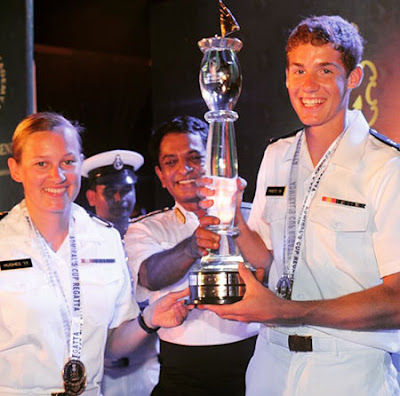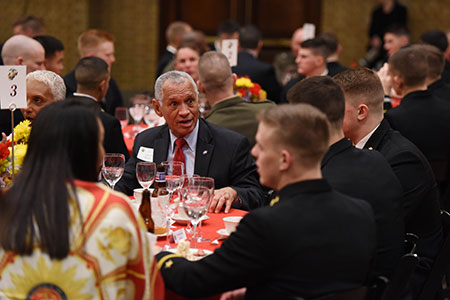In the "Letter to My Former Self" series, USNA graduates lay out the advice they would give themselves as midshipmen based on their experiences as junior officers in the Navy or Marine Corps. This week's letter was written by ENS Bobby Nefzger, a supply officer and 2014 graduate.
To preface this “letter to my former self,” I must first say that I am honored to have an amazing Naval Academy family, education, and an opportunity to serve in the U.S. Navy. This letter is a reflection on my first 18 months of post-Academy life.
My mini-bio: I am a former member of 11th company and an economics major. The group Navy Beats is my legacy; two of my best friends and I started the group in the fall semester of 2011. In May of 2014, I commissioned as a student naval aviator, but after several months in Pensacola, I made the choice to leave flight training due to medical and personal reasons. Fortunately, I was blessed with the opportunity to laterally transfer into the Navy Supply Corps. After five months of training, I now serve as a division officer on a destroyer, scheduled to deploy to the Middle East in just a few short months.
I never imagined that my post-Academy life would unfold this way, but my story is not as unpredictable as you would think. When you leave Annapolis, you’ll watch your friends go through significant life changes for months and years to come.
Many examples come to mind. Here are a few, fresh in my memory:
- My Academy roommate/best friend was dead-set on a career flying fighter jets, only to be selected for a different platform.
- One friend was moved from pilot to NFO training after a full year in the pilot pipeline.
- Some SWO friends arrived to their first ship only to be surprised by news of a homeport switch across the country or overseas.
- Classmates have endured intense breakups or even divorce.
- One SWO friend who survived a life-threatening medical situation while underway was forced to return to shore.
- One friend who selected SWO at the Academy now operates in the backseat of jet aircraft.
Like the Class of 2014, you will watch your classmates’ life stories be written and re-written by the demands of military life. I focus on these real-life examples to articulate a few key points:
1) The Academy is generally certain; little about military life is certain. Rigorous though it may be, Naval Academy life is filled with one thing: certainty. In comparison to your first years as a junior officer, the Naval Academy can seem clear and simple. I like to reconnect with graduates from prior classes to ask about life in the fleet. They all wished they knew how volatile life could be as a junior officer: trying to earn their pin, lead enlisted personnel, and competently do their job while adjusting to the needs of their superiors. When you add in your new freedoms, a family, or self-improvement, JO life becomes a challenge all by itself. Expect to be tested, just in different ways than at the Academy. I also feel compelled to stress the fact that luck and timing will heavily play into your career. Future SWOs: Your life will be heavily dictated by the command climate and general attitude of your ship. Do your research and choose your ship wisely! Future student aviators: Your platform selection will be primarily influenced by the needs of the Navy. Several classmates of mine did not receive their first choice of platform. Understand this prior to choosing a career in aviation. Though I was lucky to be selected for the Supply Corps, some of my classmates from the aviation community who applied for lateral transfer were separated from the Navy outright.
2) Know yourself. I remember a phrase repeated over and over at the Naval Academy: “Stay the course, the best is yet to come.” Even though this phrase helps midshipmen survive the Bancroft grind, this is no way to live your life! If you’re constantly anticipating a presumably-brighter future, you’ll miss out on what’s right in front of you. Remember, the military is just one component of what makes you a whole person. If you place your identity in only the military, it will define you. Know what you value in life. Don’t count the days; make the days count!
3) What it (really) means to graduate. Finishing the Naval Academy is a notable accomplishment that deserves recognition, but it is not an entitlement. Your Academy background is of little importance to your seniors, peers, and most importantly, your enlisted personnel. Like thousands of college graduates around the country, newly commissioned ensigns and 2nd lieutenants have too much “education” and little real-world experience, having come straight from the Naval Academy. Welcome back to the bottom, where your job is to learn. Observe everything. Ask questions. Fail early and often in order to achieve excellence in your profession.
4) Invest in and develop yourself. Roughly half of a typical Naval Academy class leaves active duty within their first ten years of service. Whether you serve five or forty years, you’ll need to invest in and develop yourself in order to lead a successful life. I expect every Naval Academy graduate to reject complacency in their degree alone, and to continuously improve themselves outside of their naval careers. Constantly ask yourself, “Am I growing my professional network? What books am I reading? What new topics am I studying? What skills am I improving? What qualifications am I working toward?”
5) You’re not alone. In the age of the social media highlight reel, it’s easy to feel isolated in the regular stream of your friends’ most picturesque moments – engagements, aviation solos, port visits on deployment, graduation from training commands, etc. We’re hungry to prove that all our hard work at the Academy was worth it. We demand a high, immediate return on our four-year investment. The raw truth is that most graduates ask themselves, “Where will I go from here? Will my time at the Academy have been worth it? Will I have time for family?” These feelings are completely normal, considering the shift from a life of total certainty into a life where you are paid, not to obey, but to think critically and direct a team to drive tasks to completion.
If you find yourself a few months or years into your post-Academy career reflecting on your life, remember these points. Stay humble about your background as a Naval Academy graduate. Continue to learn and experience a well-rounded life. Keep in mind that even though junior officer life can be scary and unpredictable at times, you are never alone – reach out to your classmates and know that you can relate to each other for life.
To my future alumni, I wish you the best of luck in your naval careers, and I look forward to connecting with you in the Fleet and beyond. Feel free to contact me, and know that our shared experience is one that will last for the rest of our lives.
Bobby Nefzger
ENS, SC, USN





























